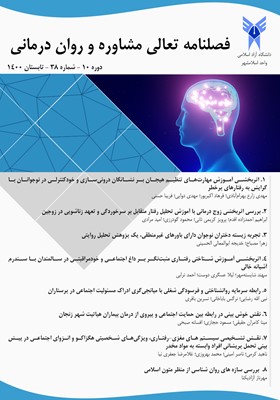تجربه زیسته نوجوانان دختر دارای باورهای غیرمنطقی، یک پژوهش تحلیل روایتی
محورهای موضوعی : فصلنامه تعالی مشاوره و روان درمانیزهرا مصباح 1 , خدیجه ابوالمعالی الحسینی 2
1 - دانشجوی دکتری، دانشکده روان شناسی، واحد رودهن، دانشگاه آزاد اسلامی، رودهن، ایران
2 - دانشیار، دانشکده روان شناسی، واحد رودهن، دانشگاه آزاد اسلامی، رودهن، ایران
کلید واژه: باورهای غیرمنطقی, پدیدارشناسی, تحلیلروایتی,
چکیده مقاله :
هدف: پژوهش حاضر به منظور تعیین عوامل مشترک و زمینهساز ایجاد باورهای غیرمنطقی در تحریفاتشناختی نوجوانان دختر به بررسی تجربه زیسته نوجوانان دختر دارای باورهای غیرمنطقی، میپردازد. روش: تحقیق کیفی حاضر پدیدارشناسی در پارادایم تفسیری با روش تحلیل روایتی با الگوی تحلیل کثرت گرا بود. جامعه آماری دانشآموزان دختر دوره دوم متوسطه منطقه 2و 5 آموزش و پرورش شهر تهران در سال تحصیلی1399-1398 بودند. 274 دانش آموز پرسشنامه سنجش باورهای غیرمنطقی نوجوانان برنارد (1988) را تکمیل کردند که از آن میان 16 نفر بر اساس ملاکهای ورود و به صورت هدفمند به دلیل داشتن نمره 5/1 واحد انحراف معیار بیش از میانگین انتخاب شدند. سپس12 نفر تا رسیدن به اشباع نظری مطالعه شدند. گردآوری دادهها با مصاحبه نیمه ساختار یافته مک آدامز بود. یافتهها: یافتههای تحقیق پس از طی فرایند کدگذاری، اشتراکات مفهومی را در بین نوجوانان دارای باورهای غیرمنطقی در 5 مضمون اصلی و 9 زیر مضمون نشان داد. این نوجوانان دارای پنج ویژگی مشترک خودکارآمدی پایین، مهارتهای ارتباطی ضعیف و نامناسب با دیگران، ارتباط ضعیف و نامناسب با خداوند، الگوی ناکارآمد رابطه والد فرزندی و مشکلات آسیبزایی در دوران کودکی بودند. نتیجهگیری: در مداخلات درمان این نوجوانان جهت کاهش باورهای غیرمنطقی میتوان بر نقش ضعف در مهارتهای ارتباطی، خودکارآمدی و ارتباطات با خداوند توجه بیشتری داشت و در مداخلات پیشگیری، مشکلات آسیبزای دوران کودکی مانند طرد و محرومیتهای هیجانی و نقش سبک فرزندپروری ناکارامد را در ایجاد باورهای غیرمنطقی مورد توجه قرار داد تا با اطمینان بیشتری جهت آموزش و بهبود سلامت روان نوجوانان حرکت کرد.
Purpose: The present study examines the lived experience of female adolescents with irrational beliefs in order to determine the common and underlying factors for the development of irrational beliefs in the cognitive distortions of female adolescents. Methodology: The present qualitative research was phenomenology in the interpretive paradigm with the method of narrative analysis with the model of pluralistic analysis. The statistical population was the female students of the second year of high school in the 2nd and 5th districts of Tehran in the academic year 2019-2020. 274 students completed the Bernard (1988) Adolescent Irrational Beliefs Questionnaire, of which 16 were selected based on the inclusion criteria and purposefully due to having a score of 1.5 units of standard deviation above average. Then 12 people were studied until they reached theoretical saturation. Data collection was by semi-structured interview with McAdams. Formal-content and critical interpretive perspectives were used to analyze the data. Findings: The research findings after the coding process showed conceptual commonalities among adolescents with irrational beliefs in 5 main themes and 9 sub-themes. These adolescents had five common characteristics: low self-efficacy, poor communication skills with others and inappropriate communication with God, dysfunctional parent-child relationship pattern, and traumatic childhood problems. Conclusion: In the treatment interventions of these adolescents to reduce irrational beliefs, the role of weakness in communication skills and self-efficacy, communication with God can be paid more attention, and in preventive interventions, harmful childhood problems such as rejection and emotional deprivation and the role of dysfunctional parenting style. He considered irrational beliefs in order to move more confidently to educate and improve adolescents' mental health.
_||_


